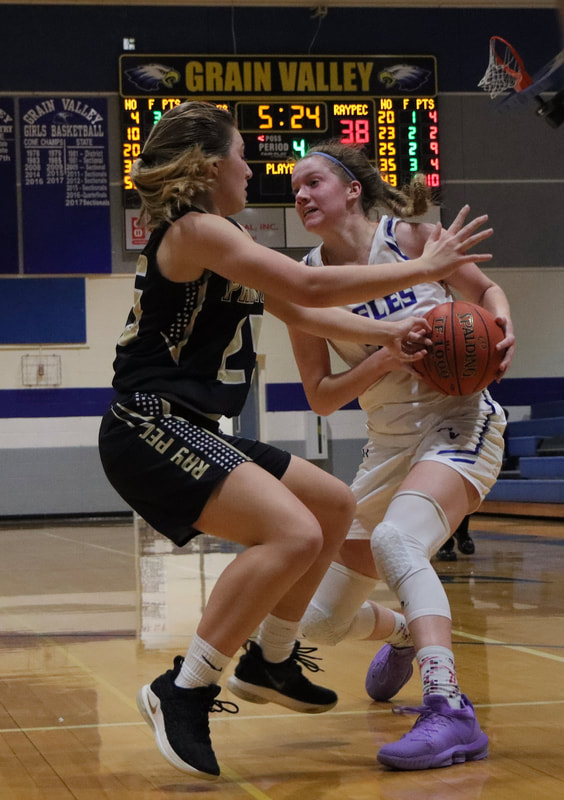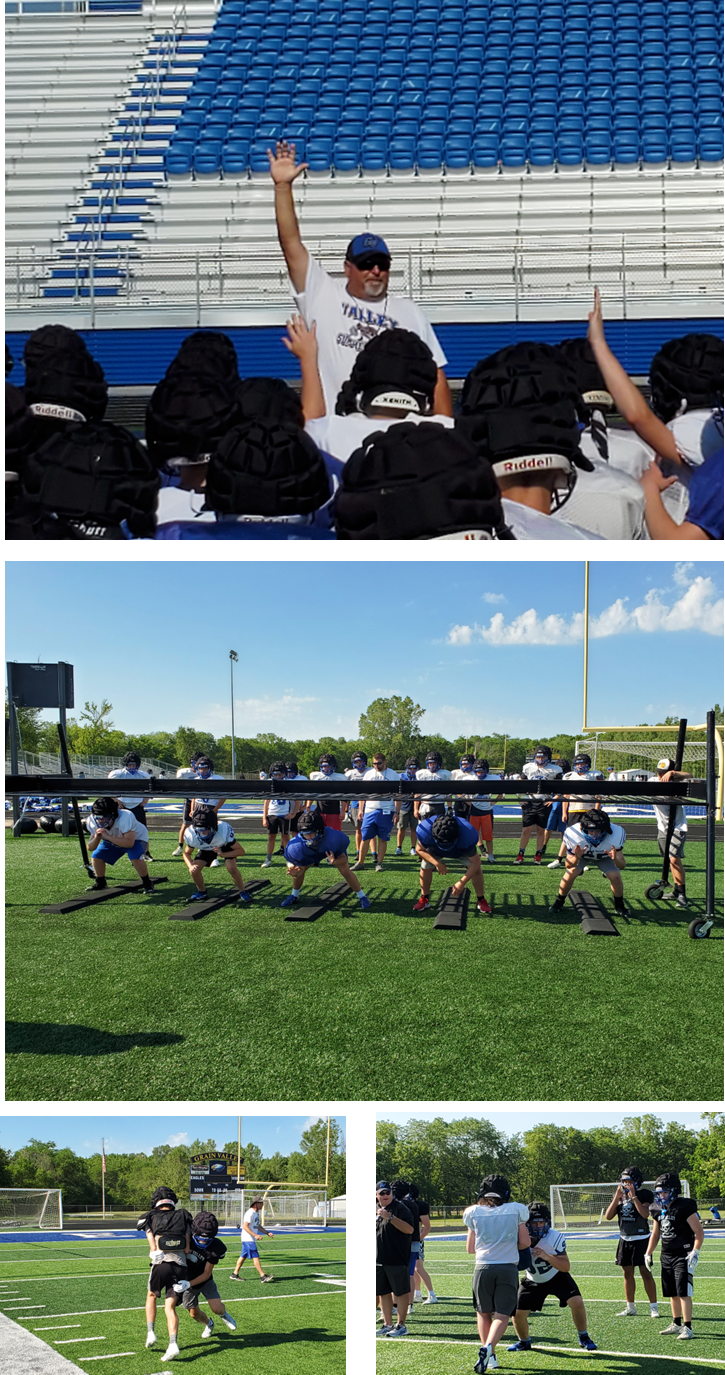|
|
After months of discussions over how to best move forward in addressing City facility needs following the defeat of a June 2020 bond issue that would have resulted in a Community Campus at the former Sni-A-Bar Farms site, the City is requesting bids for architectural services for a police building near the current city hall and police building.
Per the Request for Qualifications notice, the City of Grain Valley intends to contract for architectural services in connection with the feasibility, design and construction of a new police station and will accept sealed qualifications from qualified persons, contractors or firms until June 29th. In the proposed scope of work outlined in the request, the design team selected may be called upon to assist with a probable ballot issue in spring or summer 2022 required to fund the project. City Administrator Ken Murphy explained the proposed police station is a result of multiple discussions during Board workshops. “Through those workshops, the Board of Aldermen made a decision to move forward with planning for a new police station, located on the east end of the old football field, behind the Community Center and pavilion.,” Murphy said. “The intent moving forward is to place a police station centrally located in the City and not surrounded by residential development. These were concerns voters identified in the survey that was conducted after the election. If a new police station is ultimately agreed upon and approved, the current City Hall would need to go through a renovation to make the current police station useable for City Hall functions. The intent is to correct as many current issues as possible, but the level of renovation that happens will ultimately sit with the Board of Aldermen as they are still discussing the long-term plan for the remaining City facilities.” Mayor Chuck Johnston, whose opposition to the June 2020 Community Campus project was a hallmark of his own campaign, pointed to the cost savings of utilizing existing facilities and property. “In our survey of voters, the Board, staff and myself felt the consensus was that the majority wanted to use existing buildings and properties rather than moving to the proposed properties. As far as costs, there is a substantial savings in necessary infrastructure for any new buildings as well as savings in not scrapping the current facilities,” Johnston said. “We felt the police department was the most pressing issue. So that is were we decided to focus our attention. It also then gives us the ability after the police move out of the current building to make necessary repairs and improvements at a much lower cost than replacing City Hall. Once those two facilities are addressed we will be able to determine the best means for dealing with the Community Center. Figures at this point aren’t determined but they shouldn’t be anywhere near the project costs in the failed bond issue.” Mid-Continent Public Library announced it has expanded evening hours at its branch locations.
The Grain Valley branch, located at 101 SW Eagles Parkway, will be open Monday—Thursday from 9:00am—6:00pm, Fridays from 9:00am—6:00pm, and Saturdays from 10:00am—6:00pm. For more information on other branch locations and library services, visit www.mymcpl.org. by Michael Smith Grain Valley junior Grace Slaughter has not only established herself as one of the best girls basketball players in Missouri. That was evidenced by her sophomore season with the Eagles when she averaged a whopping 27.3 points per game (the highest in Kansas City), 7.1 rebounds, 1.8 assists and 2.3 steals and was named to the Class 6 all-state team. Last Friday, she can now say she’s one of the best girls basketball players in the United States. After a week of tryouts in Indianapolis, it was announced that Slaughter made the USA Basketball Women’s U16 National Team, joining 11 other players including Blue Springs’ Jada Williams. “They announced our names in alphabetical order, and my name was one of the last ones called since my last name starts with an S,” said Slaughter, who verbally committed to play at the University of Missouri. “It was nerve wracking for sure, but I knew I left everything out on the floor. I am so excited to get selected.” So was Grain Valley head girls basketball coach Randy Draper. “I thought she was going to make it, but the process is so stressful because it’s so selective,” Draper said. “But hey, I didn’t have to go through the process. It’s an unbelievable achievement and is a great reward for someone who works as ridiculously hard as she does.” Thirty-four finalists were selected by the USA Basketball Women’s Developmental National Committee to attend tryouts in Indianapolis. That number was cut down to 16 players last Thursday before the 12-person roster was announced the next day. During tryouts, players played scrimmage games, including 3-on-3 and went through drills. At the tryouts, Slaughter was able to display her versatility to coaches and evaluators. At 6-foot-2, Slaughter is able to play and defend multiple positions on the floor. “That was something I was really going after was to show my versatility,” Slaughter said. “I didn’t want to go in there and just be a straight 3-point shooter even though that’s something I do very well. I can go in there and be a stretch four and play on the perimeter and drive to the basket or I can play in the post. I can be whatever you need.” That versatility was what helped Slaughter guide the Eagles to a 14-7 record and a district championship game appearance during the 2020-21 season. “She can do everything,” Draper said. “She can play the point, she can post, she can shoot, she can drive and she’s a really good passer. As good as she was as a freshman, she was even better as a sophomore. She’s shooting the ball really well and she’s gotten stronger.” Slaughter has still been active playing for her AAU Team, the Missouri Phenoms, which helped prepare her for the Team USA trials. The skill she displays on the court isn’t just natural. Slaughter works diligently on her craft, and puts up shots whenever she can on the court. She even worked on her jump shot following a wrestling tournament that was held at the high school. “My mom works for the middle school, and she checks the schedule to see when cheerleading is in the gym, when is wrestling in there, when is color guard in there,” Slaughter said. “We definitely find pockets of time that I can go in there and work on my game.” Slaughter and her Team USA teammates will participate in a training camp on Aug. 4 before heading to the FIBA Americas U16 Championship which will be on Aug. 16-22 in Santiago, Chile. “I can’t wait to experience a different culture and travel outside the country,” Slaughter said. “To be able to represent your state on the national team is such an honor. I dreamt of playing on an Olympic type team. I am so excited. I am not only representing the United States and Missouri, I am representing Grain Valley. I am so pumped to go and play against great competition from other countries.” After a week of tryouts in Indianapolis, it was announced that Grain Valley's Grace Slaughter made the USA Basketball Women’s U16 National Team, joining 11 other players including Blue Springs’ Jada Williams. Photo credit: John Overstreet.
by Michael Smith The 2021 Grain Valley girls soccer season was the end of an era.
In a season where the Eagles finished 22-3-1 and made the Class 3 state championship game for the first time in program history, Tyler Nichol is not only stepping down as head coach of the girls, he is stepping away from being a teacher at Grain Valley High School. Nichol said he found a job in another field outside of education, an opportunity that he said he couldn’t pass up. After seven years as head coach of the boys and girls programs, he is giving way to assistant coach Brett Lewis, who was the head coach of the boys for the 2020 season and will be leading the girls for the first time next spring. Leaving coaching also will give Nichol more time to spend with his wife Amanda, his four-year-old son Jackson and his 2-year-old daughter Elanor. He let players of the girls team know about his decision during the second week of the 2021 spring season. “It was a family decision. I found a good opportunity outside of education,” Nichol said. “I love coaching, but it doesn’t really work out with my current role right now. Who knows what the future holds with that. Maybe I will return to coaching as my kids get a little bit older.” Nichol helped both Eagles programs become powerhouses in Missouri and finished with a combined record of 202-77-6 between both programs. Not only did Nichol lead the girls to their best season ever this spring, he helped guide the boys to final four berths in 2015 and 2016, finishing third and fourth, respectively. Stepping away wasn’t an easy decision for Nichol by any means. He admits that he will miss it. “The relationships with the parents and players is the biggest piece, I will miss that,” Nichol said. “I am in contact with a lot of former players. I received a lot of letters from former players after I told people I was stepping down. You really get to know everyone after coaching them for four years.” Throughout his seven years as coach, Nichol had so many memorable moments, it was hard for him to choose a favorite. “All three final fours were pretty special,” Nichol said. “There were a lot of good memories there that the kids will remember for the rest of their lives. For me, it was the daily grind in practice every day where you get to know the kids the best.” Now that he’s stepping away from coaching, the most logical step for activities director Brandon Hart was to hand the keys of the girls team to Lewis, who is a longtime friend and former teammate of Nichol. If there was anyone Nichol could have picked to succeed him, Lewis would have been it. The duo grew up in the same neighborhood, played on the same soccer teams, attended the same schools and spent four years playing with each other under longtime Blue Springs head coach Mike Palermo. Nichol wanted Lewis on his staff for a long time and finally got his wish in 2019 when Lewis joined him as an assistant on both teams. After a year as the head coach of the boys, Lewis will run his own girls program for the first time. Before coming to Grain Valley, Lewis was an assistant coach at Blue Springs, Oak Grove and Oak Park. He’s looking forward to the opportunity. “Coming to Grain Valley as an assistant with Coach Nichol was an opportunity I couldn’t refuse and now I am excited to be the head coach of both programs,” said Lewis, who led the boys to a 9-12 record and a district title. “I am glad that I am here and that I got to know all the girls. It will be a smooth transition.” Next spring, Lewis will retain a good amount of his starters but will lose a handful of seniors including Class 3 co-offensive player of the year Reana Childers and all-state defender Sophie Broockerd. “I think we started five freshmen in that state final game,” Lewis said. “We have a good young core that we can build around. It’s an exciting time. We are hoping to build on the legacy that Coach Nichol helped create.” Lewis said there won’t be many changes to the girls program as he and Nichol had similar coaching philosophies and similar systems they like to run. Following the best season in program history, Lewis hopes to have similar success in 2022. “Making it back to state is a great goal to have,” Lewis said. “Anything can happen after making the final four. We thought making the state final four might be a lofty goal coming into this last season and we made it. So I think getting to that game was a valuable experience for the girls. There are so many good, young girls on this team. We could have a lot of success next season, too.” by Michael Smith There was a lot of uncertainty heading into the 2020 high school football season for teams around the United States. It was no different for the Grain Valley Eagles. There was a possibility of there not being a season at all with the COVID-19 pandemic ravaging countries around the world and overloading hospitals all over. Because of the pandemic, the Eagles were not able to workout until late June, and players had to make major adjustments to the way they trained. But this season, however, has taken a huge load off the shoulders of head coach David Allie and his 80-plus players attending this year’s offseason training camps. “We’re back to normal,” Allie said. “We didn’t get to workout until the last two weeks of June. Now, we do strength and conditioning training indoors.” That’s not all. The Eagles had to move weightlifting equipment outside to workout instead of doing it in the weight room since it was easier to spread COVID indoors than outdoors. Players also had to wear masks during every workout and they had to socially distance 6 feet from each other, which made some drills difficult to do. “We were limited to what we could do outside last year,” Allie said. So what were some of those limitations? “We were wearing masks and weren’t running very much,” Grain Valley linebacker Gage Forkner said. “Wearing masks made it hard to hear people. It’s a lot easier now since we don’t have to wear masks now.” Added Terry: “Training camp is a lot more intense now. We can do a bunch of work in the weight room. It felt normal.” Allie added that his players wearing masks caused them to get fatigued easier. “It added a layer of conditioning,” Allie said. “It makes it harder to breathe and it’s harder to catch your breath. Having the freedom (to not wear masks) makes things easier. “Last year, there were no offseason training camps. We couldn’t wear helmets and pads until the end of July. That’s when we started having camps.” This season, mini camp sessions start in the first week of June and the team has been training ever since. On Tuesdays, they have been working out at Moody Murray Memorial Field at the high school. So far, the Eagles have had anywhere from 80 to 100 participants in off-season training camps. “We have been doing a lot of agility training and have been working on footwork,” Grain Valley offensive lineman Cooper Terry said. “Before practice, we worked out in the weight room. We also did some contact stuff. It was nice.” Getting a full offseason of work is going to help a Grain Valley squad that graduated 22 seniors from last season’s team. Allie said the effect of a shorter offseason for his Eagles was a lot lighter for his senior-laden team last year. Things getting back to normal couldn’t have come back for a team that will have more younger players than a year ago. “We are ahead of where we were last year,” Allie said. “The good thing about this summer is we are going to need this time together. We have a lot of inexperienced guys stepping into major roles on the team. “Last year’s situation was hard for everybody, but we at least had a lot of experience coming back and they knew what was expected. A lot of our guys now haven’t experienced what I would call a normal summer.” Added Terry: “Last year, we had maybe one or two underclassmen competing for a starting offensive line spot. This year, we have five or six, but the young guys are stepping up and working hard.” Last season, the Eagles were one win away from making the state final four. This season, their expectations haven’t changed much from one of the best seasons in program history in 2020. “We want to win state,” Forkner said. “We want to make it all the way. Right now, we want to get 1 percent better every day, so we can get 100 percent better at the end of the summer.” Photo credit: by Michael Smith
Jackson County Executive Frank White, Jr., announced his intention to run for re-election in 2022. County Executive White has served in this role since he was unanimously appointed to the position in 2016 by the Jackson County Legislature.
Upon taking office, Executive White became the first African-American to serve as chief executive in the 190 year-history of Jackson County. “I could not be more excited to make this announcement,” Executive White said. “I am proud of all that we have been able to accomplish and as we approach next year’s election, I look forward to discussing not only our accomplishments, but also my vision for the future of Jackson County.” Since his appointment, County Executive White has run for re-election twice and won both times. In the 2016 and 2018 general elections, Executive White received 82.21% and 77.3% of the respective vote totals for County Executive. Prior to being elected to the County Legislature in 2014, Executive White is best known for his 18-year professional baseball career with the Kansas City Royals. According to a campaign release, Executive White plans to make announcements about his campaign team and upcoming events in the coming weeks. The University of Missouri has announced the spring 2021 Dean’s List.
Grain Valley: Kendyll L Bailey, Senior Drake Elliot Bray, Junior, Arts & Science Warren Godfrey Haralson, Senior Shaley Elizabeth Harper, Sophomore, Journalism Austin Levi Hoagland, Sophomore, Journalism Meagan Janeen Hodges, Senior, Journalism John Daniel Hodson, Sophomore, Engineering Jackson Adam Hoover, Sophomore, Agr-Food & Nat Resources Alice Lin Sophomore, Business Madyson Lynn Marrs, Junior, Agr-Food & Nat Resources Keely Michelle McElligott, Junior, Journalism William H Perry, Freshman, Journalism Julian Mikel Sanjur, Junior, Health Professions Hannah Raleigh Sears, Junior, Arts & Science Victoria Gabrielle Seever, Sophomore, Arts & Science Alec Darian Shaffer, Sophomore, Arts & Science Kendra Renea Sibert, Junior, Arts & Science Allison Ann Smith, Senior, Arts & Science Stephen Andrew Swingle, Junior, Engineering Brett M Tieman, Senior, Education Benjamin M Totta, Junior, Health Professions Mackensie Danielle Wagner, Sophomore, Agr-Food & Nat Resources Vanessa Carla Watkins, Junior, Arts & Science Kaylee Michelle Williams, Senior, Health Professions The Central Missouri Police Academy (CMPA) at the University of Central Missouri celebrated a milestone when it graduated its 161st cadet class on June 19th. All 25 members of the graduating class have found employment, making this the first time that 100 percent of the cadets were hired at the time of graduation. Additionally, all of the cadets passed their Missouri Peace Officer Standards and Training (POST) test to become Class A Licensed Officers.
The pinning ceremony that took place at UCM involved representatives from more than 18 law enforcement agencies from across the state, with some agencies hiring multiple cadets. From this graduating class, the Warrensburg, Chillicothe, Independence, and Grain Valley police departments all hired multiple new officers for their cities and the Lafayette County Sheriff’s Department Office hired two new deputies. Other communities or Sheriff’s Departments to hire graduates of the CMPA were Carroll County Sheriff, St, Clair County Sheriff, Henry County Sheriff, Johnson County Sheriff, Grandview Police Department, Warsaw Police Department, St. Joseph Police Department, Pettis County Sheriff, Whiteman Air Force Base Security Forces, Saline County Sheriff, Lee’s Summit Police Department and Clinton Police Department. Graduating cadets joining the Grain Valley Police Department: Krista James Dustin Lancaster Several years ago, I began commuting to work. It is not my favorite thing to do. But I like the familiarity of the drive, and I am always at work honing my powers of observation, like all ladies of an age should.
On my drive I pass a house that sits on a slight hill, a bit back from the road and has a long gravel drive winding up to it. In years when we have had snow, I have felt both sorry for the owners that didn’t have a smoother surface that could be scraped or snow blown, but also somewhat envious, as they were undisturbed by the outside world, no SUV or truck tracks marring the snow covered drive. One Friday early this spring, there were trucks at the end of the drive, temporarily blocking that lane of my commute. As I got closer, I realized one of them was churning cement. Were they pouring a driveway? On Monday I craned my neck in the rearview mirror after passing the house, and to my surprise, it looked like only one fairly small section of driveway, right at the base of the hill, had been poured. I looked forward to the end of work that day—ahh, who am I kidding, I always look forward to the end of my work day. But that day, I wanted to take a look to verify the tiny driveway they had poured. Sure enough, as I slowed down to rubberneck, only one section of concrete was curing, surrounded on the other two sides by all that gravel. What in the world? Why wouldn’t you pour the whole thing? When my husband got home, I shared the exciting, albeit puzzling details. Or at least I attempted to. As my opener, I said, “I saw the weirdest thing today.” Somewhat intrigued, because likely he thought I had seen someone with a third eye or a 50 something year old with a really good mullet, he inclined an ear toward me, a sure invitation for me to continue. “Yeah, you know that house that sits sort of on the hill on the right, just before our turn, with the gravel driveway?” “No,” he said, without even trying to access the route in his mind, “I guess I never saw it.” “Well, of course you saw it,” I said, suddenly desperate to cement a reference in his mind for this fabulous story I was getting ready to tell. “You drive past it all the time.” “I just can’t picture it,” he said, “but go ahead with the story.” In that moment, I had a choice to pout about him not noticing the same things I do or to have at least a smidgen of a viable dinner conversation topic, so like Lewis and Clark, I pushed bravely forward. “Well, they have a gravel drive, but…” I started, when he interrupted and said, “Yeah, that’s what you said.” “That’s not the whole story!” I whined. “Oh, well that is weird or at least kind of unusual to have a gravel drive in the suburbs, so I just thought that is what you meant,” he said, now fully engaged. “There’s more?” Setting his threshold of weird aside, I told him about the cement truck and the resulting single section of driveway it had poured. “Okay, go ahead,” he said. “Well, that’s it. I mean who pours one section of driveway? That is just weird.” Maybe it was my tone or the volume at which I emphasized the word weird, but he paused for just long enough to make me think he was thinking about what I had said and considering the level of weirdness. “Hmmm. I have a question,” he said. “Do you want possible explanations, a rating from 1 to 10 of how weird that is or isn’t, or would you just be satisfied with my initial hmmm?” I wanted a discussion, which was not one of his options. Before he could offer me his list, I offered mine. “I know that sometimes concrete companies will schedule a driveway when they know they will have extra concrete mixed from a big job, and it saves the homeowner money. Maybe that’s it. Or maybe the grader they were using to level the gravel threw craps, and they couldn’t level the other sections. Or maybe they got to pouring it, and it was too thick or too thin. Or maybe some of the workers were sick with COVID, ” I said breathlessly. When he didn’t bite on one of those explanations, I ruminated further. “I think they poured it Friday, and wasn’t it supposed to rain over the weekend? Maybe they just thought the weather wouldn’t cooperate for it to cure correctly. Or maybe…nah, this is too crazy…maybe the wife commissioned the driveway and the husband didn’t really want it and he just stopped the work! Or maybe the crew got there with the invoice, looking for payment and the amount was way more than they anticipated, and they could just afford a section!” He smiled like he does when he knows more than me. I should tell you it isn’t his best look. “Maybe they just decided to do it piece by piece,” he mumbled under his breath. Mind blown at his simplistic explanation and lack of willingness to gnaw that bone right down to the marrow, I said, “Well, that’s just dumb,” mimicking Ricky Bobby, one of my most favorite cinematic characters of all time. To my husband, that was not at all dumb. He started a Perry Mason like defense of all the things that were better done piece by piece. He talked about some dessert that you start one day that gets refrigerated, and then you complete it the next day, like in two pieces. I countered with the idea that recipes were done in steps. He countered with puzzles. He meandered his way into quilt making and mosaic art. I teased him about his love for crafts. He said he thought there was maybe even an ACDC song with the name Piece by Piece, and I resisted the urge to tell him it was Kelly Clarkson who sang it and question his very manhood. ACDC, pshawwww. We ate the rest of our dinner in silent contemplation about pieces, until our daughter interrupted just long enough to share her desire to have curtain bangs cut into her beautiful all one length hair, and the shock of her announcement sort of pulled me out of the debate. About an hour later, my husband said, “Do you remember a TV show called Piece by Piece?” I didn’t bite. “I can’t remember if we watched it together or I just watched it. It was about graffiti artists in California,” he said. “You Googled piece by piece, didn’t you?” I said. Unphased, he said, “Pizza. Pizza is a piece by piece thing.” No argument there, most of us do eat it piece by piece. I know why he understands the single driveway panel. He is a piecer, and yes, I just made that word up, according to my grammar checker. He pieces together outfits, ones that incorporate lots of patterns and lots of colors, none of which the rest of us would match. The results are dazzling. He pieces together long, often rambling prayers at family dinners, praising God for everything from good steaks to temperate weather and implores him for help with everything from slowing down golf cart drivers in our neighborhood to good boyfriends for our girl to real things like curing cancer. He manicures our shrubbery in pieces, working until he tires, and then attacking it again another day. My Edward Scissorhands likes to piece away the branch which results in a sort of late 80’s asymmetrical bob on our boxwoods. Under pressure from our maid (me), he cleans off his dresser top piece by piece, examining each item like it belongs in a gallery, whereas I would just rake my forearm across the whole mess the night before trash day and sneak it out. In the months since the tiny drive was poured, I have romanticized that concrete, thinking about it on my daily commute. Perhaps they wanted to see the color of the concrete once it was cured, kind of like trying to find the right blue paint for a bedroom wall with little swatches. They probably just gazed out their picture window at it each day. The deeply sentimental part of me imagined a little grandson who would be so enamored by a concrete truck, that they postponed until he could be there with them to see it poured. I assumed he lived in either Portland, where it rains so much it is hard to pour concrete or in Mississippi, where it is so muddy that the concrete just sinks in. Concrete is a big deal to little boys. The patriotic part of me just knew their son has been serving in the military in an overseas occupation, had finally gotten word of his discharge, and they wanted to afford him one last view of his boyhood gravel drive, and thus had halted the work while he made his way home, perhaps not arriving until months and months from now. A few friends with the same commute also noticed the drive, and it was a good topic of discussion. We assumed they had committed to the ‘soul patch’ look. Then one day, as spring turned to summer, the concrete truck re-appeared. A friend texted me the news. Talk about exciting! The driveway would be finished! The grandson had come to visit! The son had said a tearful goodbye to the gravel! I mentioned at dinner having seen the truck at the house again, and my husband patted my hand and said he was glad I wouldn’t have to worry about the driveway anymore. He didn’t hear me when I mumbled that I would give him something to worry about. I looked forward to my commute, maybe even catching a glimpse of the chubby-cheeked grandson, holding the granddad’s hand, just standing there admiring the magnificent new driveway. I planned my neighborly wave, which would turn into a thumbs up, acknowledging their patience and the beautiful new addition, complete with the anchoring initial piece. Why was I surprised when I saw they had just poured only one more single section, adjacent to the original piece? They truly are piecers, my husband’s kindred spirits. I promise you I will not be bringing it up at dinner. Cathy is a retired public school English teacher and Public Information Officer. I’m sure you have read about the ransomware attacks that occurred against the Colonial Pipeline that caused them to shut down production.
Ransomware attacks have been on the rise for years now and it is not showing any signs of slowing down. If you want to keep your personal or business devices safe from ransomware attacks, check out these quick and easy tips that will help you keep safe. Every time I talk about cybercrime, I always have to state this statistic. 99% of cybercrime requires user interaction. This means as long as you're not clicking on links in emails or visiting questionable websites, all of your devices are protected from most cyber threats. Prevention is better than protection when it comes to ransomware. These attacks were originally designed to prevent access to your files, but now criminals are stealing your data as well as ensuring you pay the ransom. Here's how you can keep safe: 1. Update your tech. It doesn’t matter what type of device you use, make sure it’s up to date. Many of you think you’re immune from these types of attacks because you’re not using a Windows device. Even though this attack was designed to infect Windows computers, it does not mean you’re immune. Verify automatic updates are enabled on your device. Also, make sure you’re running the latest operating system for your device. Cybercriminals will target older technology because they know the manufacturer no longer provides security updates for these devices. 2. Start using an automatic cloud backup service, today! The most dangerous aspect of ransomware is its ability to infect computers and devices connected to a network. You may backup your information to an external hard drive, or to a cloud service like DropBox or OneDrive, but guess what? Ransomware can infect those files as well. How does a cloud backup service help you? Most cloud services like Carbonite (www.carbonite.com) keep multiple copies of your files across many services across the globe. If your backup gets infected with ransomware, your cloud backup provider can simply restore your files before the infection happened. 3. Use common sense when it comes to email. Hackers aren’t concerned about getting into your computers or network anymore. They get your information by phishing scams that are socially engineered to make you react to what is being said in an email. These emails come in the form of mail from your friends or from companies you have grown to trust. Always verify the email by looking at the email address. If you get an odd email from a friend, pick up the phone and ask if they meant to send you the letter in question. If you aren’t sure, just simply delete the email. It’s better to be safe than sorry. 4. Use Anti-Virus software on your devices. Anti-Virus software isn’t full proof and for the most part, one isn’t better than the other. It’s something you need to have on your device (meaning Windows, Macintosh, Smartphone, or Tablet). The anti-virus that is actively scanning your device decreases the chances you will fall victim to a ransomware scam. 5. Never Pay The Ransom. Yes paying the ransom, might get your files back and prevent criminals from sharing your personal information, but it's never a guarantee. So what happens if you get infected with ransomware? Unplug your desktop computer and take the battery out of your laptop. Disconnect your computer from your wired or wireless network and unplug it from the wall. Ransomware users can remotely power up computers. Give us a call here at Integral. We may not be able to retrieve those lost files, but we can make sure you don’t fall victim to a ransomware scam. Ransomware isn't going anywhere. Make sure you're taking steps to stop these attacks before they happen. No one wants to be in a position where they lose access to their important documents, photos, and videos. Want to ask me a tech question? Send it to [email protected]. I love technology. I've read all of the manuals and I'm serious about making technology fun and easy to use for everyone. |
Categories
All
Archives
July 2024
|
Grain Valley NewsGrain Valley News is a free community news source published weekly online. |
Contact Us |












 RSS Feed
RSS Feed
